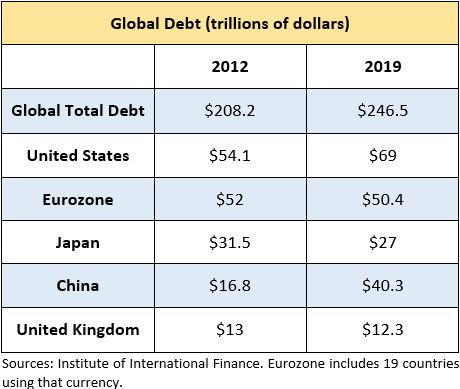Will the global debt bomb explode again?
July 17, 2019By Robert Samuelson
Debt is the crux of the matter. If you want to understand what makes the world vulnerable to a global recession or, possibly, something much worse, you’ve got to come to grips with the worldwide debt buildup. It’s not the only candidate for calamity, but it ranks first among the possibilities.
At the end of March, worldwide debt totaled $246.5 trillion, reports the Institute of International Finance (IIF), an industry research and advocacy organization. That was nearly 320% of world gross domestic product (GDP), up about 20 percentage points since 2012. Although no one knows how much can be borrowed safely, the dangers are obvious. Too much borrowing may lead to default or — to meet their debt obligations — reductions in other spending.
President Trump surely grasps the political implications. Little wonder that he so single-mindedly pressures the Federal Reserve to cut short-term interest rates. As it turns out, debt is a double-edged sword. Borrowing may initially quicken economic growth, as funds are disbursed and spent. But if borrowers can’t repay or struggle to repay, economic growth may suffer.
What further confuses the situation is that different countries have different experiences and different tolerances for debt. The United States — to take an obvious example — has so far shown a relatively high tolerance for borrowing. One reason: Dollar securities, U.S. Treasury bonds and the like, are considered “safe assets” that will be repaid when they mature.
Glance at the table below. It shows the debts of large nations and of the world. The debt figures include total borrowings of households, non-financial businesses and governments. The loans come in many forms and maturities, ranging from home mortgages to business loans to government bonds.

The table’s inescapable message is that, since at least 2012, the economic recovery has depended heavily on the assumption of more and more debt. In some countries, the stimulus has come from added government debt. In others, business and household borrowing have taken the lead.
But regardless of the sources of borrowing, the questions it raises are similar. How much longer can the borrowing boom continue? If it falters, will other sources of spending — consumers reducing their savings or businesses increasing new investments — take up the slack? If so, will the economic slowdown be mild or more serious?
So far, low interest rates have helped sustain the global economy. But there are limits to how much this can continue. China has just reported the slowest growth rate (6.2% over the past year) since 1992, despite easy money.
Economists at the IIF worry that the worst is still to come. Borrowing by emerging market countries — Brazil, India and China, for example — represents about 30% of global debt, the IIF reckons. Almost $3 trillion of these loans and bonds have to be renewed (“rolled over”) by the end of 2020. These represent financial vulnerabilities. High debt levels at some U.S. and European firms also pose dangers.
The question remains: Will the debt bomb explode again?
(c) 2019, The Washington Post Writers Group














